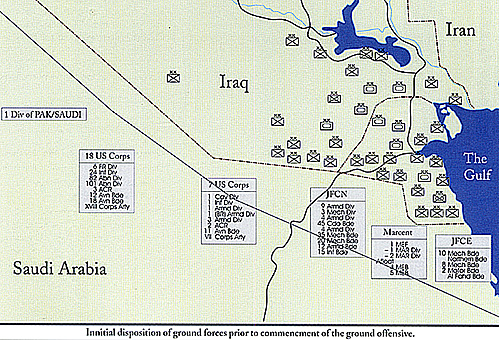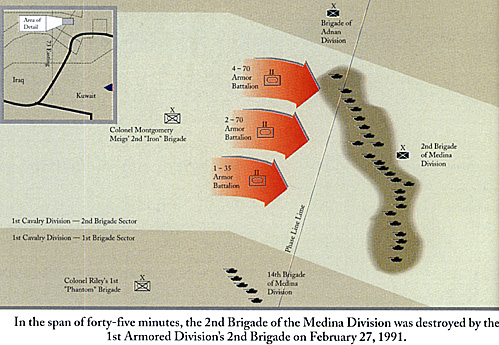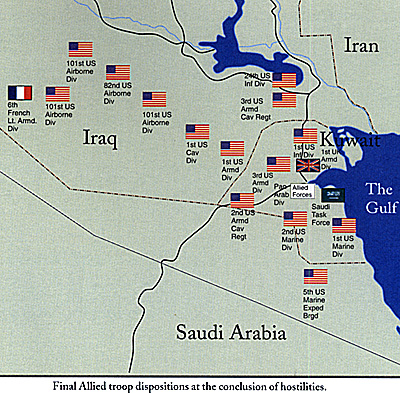 Operation Desert Storm is perhaps the
best-known and least understood military
operation of recent times.
Operation Desert Storm is perhaps the
best-known and least understood military
operation of recent times.
We all know what happened and to a large extent why. But the details remain obscure. Perhaps it was the poor press coverage (in part predicated by the media pools and operational security restrictions) or, possibly, in this age of the ten-second sound bite, no one wants to be bothered with details.
Whatever the reason, it is time to shed more light in the dark corners of Desert Storm and dispel some assurntions. Here are some well known Myths.
Myth Number One
Iraqi losses where devastating. Over 100,000 killed was the casualty figure floated immediately after the war. It was probably grounded in kill ratios based on a 600,000 man Iraqi presence in Kuwait. Subsequent analysis has led many to believe there were no more than 375,000.
Utilizing numerous eyewitness accounts, anecdotal interviews with Iraqis, and after-action reports, former DIA analyst John Heidenrich states Iraqi killed probably numbered no more than 8,000, with another 24,000 wounded.
Myth Number Two
Airpower was the decisive element in Desert Storm. Although it's true that airpower was important, as is any part of the combined arms equation, it was not the be all and end all. Airpower negated the Iraqi air force; allowed the Army's Apache helicopters to operate effectively; and blinded, attrited, and demoralized the Iraqi army.
However, it did not capture Kuwait or destroy the Republican Guard. A captured Iraqi armored battalion commander claimed that he lost five of his battalion's 44 tanks during the two-week air war. The rest were wiped out in ten minutes of combat with American mechanized forces.
Myth Number Three
High Technology won the war. Not quite. It still took well-trained, courageous men. The M1A1/A2 is arguably one of the best fighting vehicles in the world, as is the Bradley infantry fighting vehicle.
Add to that the F-15, F-117, F-14, the Navy's Aegis class cruisers and other vessels, and the Americans have the most technologically advanced fighting force in the world. This technology provided the coalition men and women with an advantage that their training, courage, and commitment allowed them to press to the fullest. No matter how technologically slick your stuff is, the troopers have to know how to use it, and be willing to do so.
Frequently, the difference in training between the combatants was the deciding factor in engagements with Iraqis. During their attack on the Iraqi crossroads village and supply dump of Al Bussayah, Americans of the 6-6 battalion of the 2nd Brigade of the 1st Armored Division inadvertently bypassed numerous Iraqis hidden in bunkers.
As the battalion's Bradleys and Abrams churned past unseen Iraqi positions, Rocket Propelled Grenade (RPG) teams would pop up and fire. An RPG-7 is useless against the M-1's frontal armor but deadly against its rear, or against any aspect of the Bradley. None of the RPGs hit. The Iraqis failed to "lead" their fast-moving targets. The American belief in and adherence to a fluid, hard-hitting doctrine coupled with the Iraqis poor training prevented American casualties.
Not all encounters were as lopsided. On the afternoon of 20 February (that's right, four days before the ground war "officially" started), Colonel Randolph W. House's 2nd "Blackjack" Brigade of the U.S. 1st Cavalry Division headed north up the Wadi al-Batin.
The wadi was long, fairly wide, and at places up to thirty meters deep. It extends north from the Saudi town of Hafar al-Batin into Iraq, roughly paralleling the western Kuwaiti border. The Iraqis believed it would be a major avenue for the attack into Kuwait. House's job was to reinforce that notion by conducting a brigade-sized feint up the wadi.
Ten kilometers into Iraq, House's men routed a battalion of Iraqi armor (T-55s and BMPs). While pursuing the battalion's remnants, the 2nd Brigade rolled into an Iraqi trap. AT-12 100mm anti-tank guns hidden in the crevices of a wadi opened up on the Americans. A Vulcan anti- aircraft vehicle was hit and destroyed. Then the Bradley carrying the lead battalion's executive officer suffered a catastrophic hit, and a Bradley rushing to the victims' aid was also knocked out.
An M-1 rolled over a mine, damaging the tank. Then came the barrage. The Iraqis had hidden over 100 artillery pieces in the wadi and they began to fire.
Despite all this adversity, there was no panic. The soldiers rescued their stricken comrades. The brigade returned fire, suppressing or destroying the Iraqi anti-tank guns. A-10 Warthogs silenced the artillery from the air. Hours later, their mission accomplished, the brigade withdrew.
 Myth Number Four
Myth Number Four
We crossed the border, and the Iraqis ran home. This statement is the impression Americans who weren't there have of the Iraqi military. I once had a lengthy debate with a Naval Intelligence officer on the subject. He claimed there was no retreat, no withdrawal, merely a headlong rush north. I asked him what he thought of Medina Ridge, the largest tank battle of the war.
"What was that?" he asked. I rest my case. Many Americans have little appreciation for how difficult some of the battles were or how hard many Iraqi units fought.
Most of the eighteen divisions manning the Saddam line were poorly trained, equipped, and fed reservists that had been recently activated since the August 1990 invasion. They were mere speed bumps for the coalition forces, performing abysmally, literally melting away in the face of the coalition ground assault.
However, the regular Iraqi armored forces (not to mention the elite Republican Guard) frequently fought with tremendous courage and determination.
Medina ridge was the biggest and perhaps most one-sided tank battle of the war. On the afternoon of 27 February, the "Iron Brigade" (of Gettysburg fame) was moving eastward across the Iraqi desert. Its three tank battalions (4-70, 2-70, and 1-35) were shoulder to shoulder. Its mechanized infantry battalion, the 6-6, was held in reserve. Here the terrain was rougher; a series of slopes interrupted their line of sight. The Americans passed through a wadi thick with vegetation, crested a ridge, and were suddenly face to face with the 2nd Brigade of the Medina Republican Guard division.
The Iraqis were well dug in and camouflaged in a classic reverse slope defense. unfortunately for them, the American's thermal sights homed in on the signature from hot gun tubes and recently started engines. Some Iraqis, realizing that to start their engines meant death, attempted manually cranking their turrets to bring their guns to bear.
The gesture was futile against the fast-moving Americans. The M1A2's thermal sights allowed their gunners to target the warm tank commander's head protruding above the cold, yet-to-be started T-72s.
Iron Brigade troopers said they looked like floating bowling balls. Earthen berms provided little cover for the Iraqis; the American's Sabot round, called the silver bullet, would blow through the sand berm and still pierce the tank's armor. In little over forty minutes the Americans had annihilated the Iraqi armored force. The Battle of Medina Ridge witnessed the destruction of 69 Iraqi tanks and 43 other armored vehicles Yet the tankers of the 2nd Brigade of the Republican Guard Medina Division did not panic or flee. Many of the Iron Brigade soldiers were astounded by the Iraqis' courage even when facing certain death.
Myth Number Five
The war's outcome was preordained. The Iraqis were destined to lose, we were destine to win. Maybe, maybe not. Actually, Saddam Hussein developed a sound, two-part strat egy He intended to split the coalition through diplomacy or treachery If that failed, he hoped to attack the coalition's weak link--the western democracies' public opinion.
The first part of the strategy did indeed fail; neither linkage nor Scuds were able to break the coalition. Next, Hussein hoped to turn the West's public opinion against the war by inflicting unacceptable casualties on western forces.
He stated, "Yours is a society which cannot accept 10,000 deaths in one battle. This statement may be true, but to find out you first have to inflict the 10,000 deaths.
The execution fell short. The lraqi front line "speed bump" units, tasked with mitigating the attrition process, were ill-equipped fight the coalition forces. As stated earlier, they were predominately reserves. The line of armored reserves, intended to slow the coalition advance, never knew what hit them. Sadam's refusal to commit the Iraqi Air Forc (IAF) denied his ground troops any knowledge of enemy dispositions. If the IAF had surged into the air after the start of the ground war, it might have achieved a rough air parity for a day or two. This parity could have provided enough air cover and intelligence to enable the Iraqi armored forces to mass and effectively counterattack the coalition.
Finally, the Iraqis misused their Scuds. Fired in ones and twos they were merely a terror weapon. What if a fusillade of them had been fired at Dhahran or any of the huge logistical/supply centers VII Corps had massed near the border? Certainly the casualties and material loss would have been a severe setback.
 Myth Number Six
Myth Number Six
We should have finished the job while we were over there. Well... that definitely makes for good press. It's got a nice simplistic ring to it. The problem is, what is the definition of "finish it" and what do we do after the mission is completed?
If "finish" it meant marching to Baghdad to dispose of Saddam Hussein, the country would have had to recalibrate its fun meter. The casualties in a fight for the country's capital would have been significantly greater than what we had actually experienced.
What if we had assassinated Hussein? Who would be the new Iraqi ruler? The Saudis were nervous about beating the Iraqis too badly or allowing the heavily Shiite and pro-Iranian portion of southern Iraq to break from the country. They did not want a radical fundamentalist splinter state on their border.
There are many other stories from the Storm, as well as tales of courage on both sides. Conceivably the biggest loser in the war, besides the Iraqis, was the press corps. It's a shame that it took years for the details of the war to be readily available. It would have been nice to understand fully the depth of sacrifice and courage of the men and women we cheered and of the adversaries we continue to underestimate.
Back to Table of Contents GameFix # 4
Back to Competitive Edge List of Issues
Back to Master Magazine List
© Copyright 1995 by One Small Step, Inc.
This article appears in MagWeb.com (Magazine Web) on the Internet World Wide Web.
Other articles from military history and related magazines are available at http://www.magweb.com